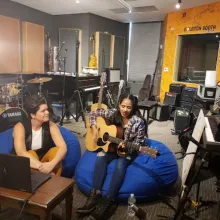
Youth Work Isn’t as Sweet as You Think – And It’s More Urgent Than You’re Imagining.
The kids are alright, right? Well, if they are, or have a chance to be, it’s in large part because of a nonprofit sector called Creative Youth Development (CYD) or Creative Youth Development and Success (CYDS).
Over the past twenty years, rising costs of living, suburban sprawl, failing public schools, outrageous costs of higher education, the flight from organized religion, and a music and entertainment industry that both commodifies artists and has no career pathway have necessitated an increase in services from CYDS providers.
I’ve proudly worked in this sector since I served as a Peace Corps Volunteer at the age of 22. Technically, while doing youth work in rural Nicaragua, I was still young enough to receive services from the CYDS sector–and only now that I’m 40 do I realize just how much young adults still need us–and just how young the early 20s truly are.
CYDS providers are attempting to fill the widening gap in services that the government and private sector can’t seem to tackle: social services, child-care, education, career readiness, mental wellness, suicide prevention, reproductive education, health and safety, drug prevention and diversion, play, arts education, and creative expression, to name a few. That’s a lot for a small sector to take on–especially when most people don’t know about us or imagine us shooting hoops and making art with “troubled” teens–and then sending them on their way to a better life filled with new promises (cue the corny montage music).
The truth is, CYDS work is social work, economic work, community work, workforce development work, and creative work. It requires both the presence of mind to address immediate needs of young people (often a crisis, or sometimes, even worse, apathy) and long-term strategies to prepare the next generation of dreamers, doers, thinkers, creators, problem solvers, and the music and entertainment workforce. For years I’ve been attempting to take the sugar-sweet perception out of Youth on Record’s work.I once had someone sing to me “I believe that children are our future” from Whitney Houston’s “Greatest Love of All” during a job interview. It was cringeworthy, to say the least, not just because of the awkwardness of the moment, but because of the simple platitude. You believe that children are our future? Um–who else is the future, if not the world’s literal next generation? Also–what does that even mean (no offense to Whitney)?
I wish working with kids was as sweet and simple as everyone thinks it is. I really do. As a nation, we’ve done something quite strange around kids and youth–we either infantilize them, or we villainize and fear them. Kids are cute. Teens are terrifying. And there’s not much in between. We’ve done the same to CYDS workers and Teaching Artists–treating them as pseudo-professionals who couldn’t “make it” in the Music and Entertainment industry. The truth is, CYDS work and the Teaching Artists and nonprofit professionals at the helm bring a special blend of grit, determination, artistic talent, and compassion that is rarely found in the workforce–which is why youth mentors, Teaching Artists, and coaches are some of the most important people in the community.
My hope is to educate our community about the need for the CYDS sector–and to make a case that the future of Music & Entertainment is dependent on quality CYDS programming starting now. This will take more resources, more committed Teaching Artists to work in this sector, and a deeper commitment from all of us to reimagine what’s possible. We need to put youth work at the forefront of the Music & Entertainment industry, as opposed to the backburner, where it’s previously lived.
At our conference, and over the next few months, I’ll be digging into three specific areas in hopes to broaden support for Creative Youth Development and Success:
1. To understand the complexity of youth work, we have to go back to the relatively new idea of the “ American teenager.”
2. To understand the urgency of youth work, we have to understand the youth mental health crisis in the USA–and be willing to face it.
3. To understand how youth work impacts all of us (or will in five to ten years), we have to understand the changing nature of work itself.
I hope you’ll join me on my quest to expand our knowledge of this sector. After all, all of our futures depend on it (cue the ominous end-credits music).


